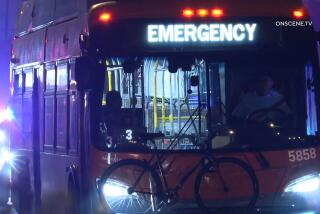Negotiations on MTA Bus Overcrowding Break Down
- Share via
Negotiations between the Metropolitan Transportation Authority and bus rider advocates broke down Wednesday, throwing the troubled agency’s future squarely in the lap of a court-appointed special master and U.S. District Judge Terry J. Hatter Jr.
Only hours later, civil rights attorney Constance L. Rice stood on the steps of the MTA’s opulent headquarters and accused agency officials of systematically deceiving the media, the public and Congress about the magnitude of overcrowding on Los Angeles’ bus system.
Rice, who four years ago filed the landmark civil rights lawsuit that put the MTA under the federal court’s authority, was armed with statistics showing that many MTA bus lines are carrying so-called crush loads of passengers, far above the level of a court-ordered limit of 15 standing passengers. In some cases, crush-loaded buses carry as many passengers standing as seated.
Along with leaders of the Bus Riders Union she represents, Rice demanded that Special Master Donald T. Bliss and Hatter enforce a 2-year-old consent degree and order the MTA to place a massive order for new buses.
In fact, Bliss and ultimately Hatter must determine the legal remedy for the MTA’s now-acknowledged failure to meet the consent decree’s requirements to reduce overcrowding on the nation’s second-largest bus system.
After days of on-again, off-again meetings, a joint working group of MTA officials and bus rider representatives failed to reach agreement on a unified response to the special master about the number of times the transit agency has violated the overcrowding limit. Instead, the two sides sent separate filings to Bliss on the extent of noncompliance with the consent decree.
Eric Mann, leader of the Bus Riders Union and the Labor/Community Strategy Center, said the data show a “massive, systematic and complete violation of the consent decree.”
In a prepared statement, MTA Chief Executive Julian Burke said 75 of the 79 bus lines that carry the vast majority of MTA’s passengers had at least one instance of overcrowding above the limit set by the federal consent decree.
But he argued that the standard of measurement imposed by the special master in a recent ruling is “so restrictive that inevitably all of our lines will fail at least once.” And Burke said that “every major city bus line in the country would also fail this test” if it applied to them.
Unfortunately for the MTA, the overcrowding limit applies only to the agency, because it agreed to reduce the number of people riding its buses while standing to settle the civil rights lawsuit that said the agency discriminates against poor and minority bus riders.
On Wednesday, Burke was en route to Washington to lobby Congress for more federal funds to finish the Metro Rail subway to the San Fernando Valley.
It was a confluence of events that the MTA has feared for years--the collision of the agency’s preoccupation with completing a $5-billion subway system with increasingly strong legal demands for an immediate end to the MTA’s long neglect of the bus system that is the backbone of Los Angeles mass transit.
Rice, Mann and members of the Bus Riders Union stood outside the MTA’s Gateway Center high-rise to demand that the agency stop spending for the subway, a light rail line to Pasadena and the Alameda Corridor rail project until it commits to buying 1,600 new buses to replace MTA’s aging and breakdown-prone fleet.
MTA’s deputy chief executive Allan Lipsky later engaged in a debate with Bus Riders Union organizer Kikanza Ramsey.
“It’s not fair to say where are the buses?” Lipsky said. “To say just go out and buy 1,600 buses and have them here in the next two years is simply impossible.”
Ramsey shot back that the MTA needs to sign a purchase order to buy more buses, if it is to deal with the overcrowding problem.
Lipsky said later that the agency knows it needs more new buses, but he declined to cite a number. Instead, he said, Burke will go to the MTA board in the near future with a request to buy more buses.
On the defensive, MTA officials sought to downplay the violations as an infrequent occurrence, a contention flatly rejected by bus rider advocates.
Even using a less strict standard than Bliss ordered, MTA’s own data show that the five worst bus lines were in violation of the overcrowding standard between 5% and 10% of the total time periods checked between last September and last month.
The less restrictive approach uses fixed 20-minute periods every hour, instead of averaging the number of passengers standing on MTA bus lines during any 20-minute peak period.
More to Read
Sign up for Essential California
The most important California stories and recommendations in your inbox every morning.
You may occasionally receive promotional content from the Los Angeles Times.










